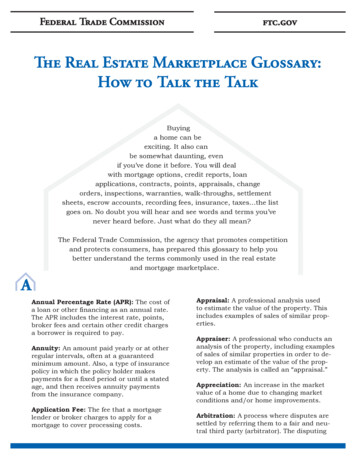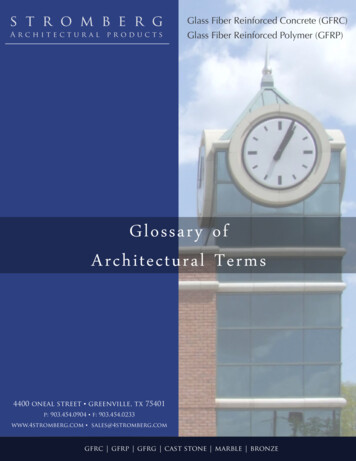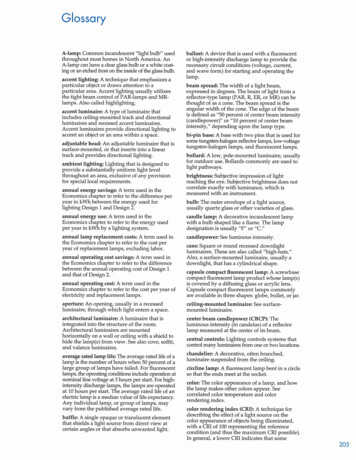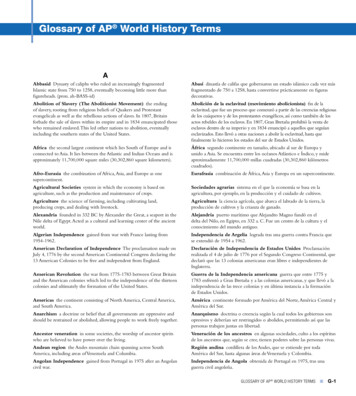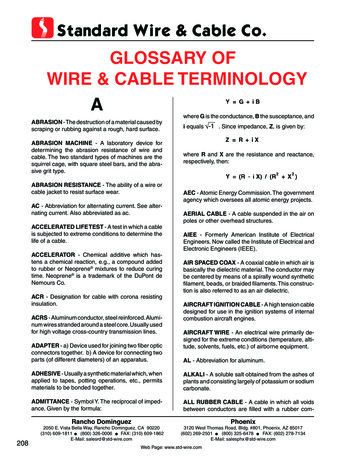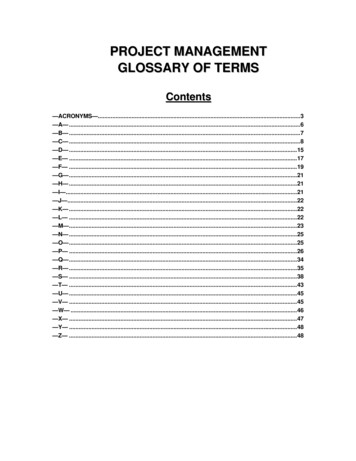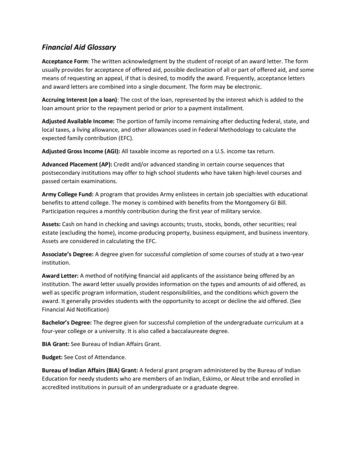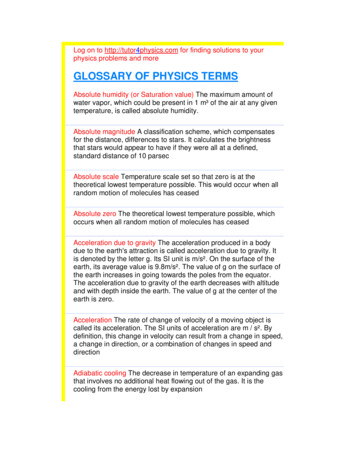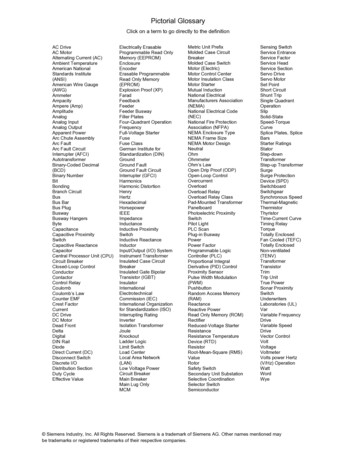
Transcription
Pictorial GlossaryClick on a term to go directly to the definitionAC DriveAC MotorAlternating Current (AC)Ambient TemperatureAmerican NationalStandards Institute(ANSI)American Wire Gauge(AWG)AmmeterAmpacityAmpere (Amp)AmplitudeAnalogAnalog InputAnalog OutputApparent PowerArc Chute AssemblyArc FaultArc Fault CircuitInterrupter (AFCI)AutotransformerBinary-Coded Decimal(BCD)Binary NumberBitBondingBranch CircuitBusBus BarBus PlugBuswayBusway HangersByteCapacitanceCapacitive ProximitySwitchCapacitive ReactanceCapacitorCentral Processor Unit (CPU)Circuit BreakerClosed-Loop ControlConductorContactorControl RelayCoulombCoulomb’s LawCounter EMFCrest FactorCurrentDC DriveDC MotorDead FrontDeltaDigitalDIN RailDiodeDirect Current (DC)Disconnect SwitchDiscrete I/ODistribution SectionDuty CycleEffective ValueElectrically ErasableProgrammable Read OnlyMemory (EEPROM)EnclosureEncoderErasable ProgrammableRead Only Memory(EPROM)Explosion Proof (XP)FaradFeedbackFeederFeeder BuswayFiller PlatesFour-Quadrant OperationFrequencyFull-Voltage StarterFuseFuse ClassGerman Institute forStandardization (DIN)GroundGround FaultGround Fault CircuitInterrupter (GFCI)HarmonicsHarmonic anceInductanceInductive ProximitySwitchInductive ReactanceInductorInput/Output (I/O) SystemInstrument TransformerInsulated Case CircuitBreakerInsulated Gate BipolarTransistor sion (IEC)International Organizationfor Standardization (ISO)Interrupting RatingInverterIsolation TransformerJouleKnockoutLadder LogicLimit SwitchLoad CenterLocal Area Network(LAN)Low Voltage PowerCircuit BreakerMain BreakerMain Lug OnlyMCMMetric Unit PrefixMolded Case CircuitBreakerMolded Case SwitchMotor (Electric)Motor Control CenterMotor Insulation ClassMotor StarterMutual InductionNational ElectricalManufacturers Association(NEMA)National Electrical Code(NEC)National Fire ProtectionAssociation (NFPA)NEMA Enclosure TypeNEMA Frame SizeNEMA Motor DesignNeutralOhmOhmmeterOhm’s LawOpen Drip Proof (ODP)Open-Loop ControlOvercurrentOverloadOverload RelayOverload Relay ClassPad-Mounted TransformerPanelboardPhotoelectric ProximitySwitchPilot LightPLC ScanPlug-in BuswayPowerPower FactorProgrammable LogicController (PLC)Proportional IntegralDerivative (PID) ControlProximity SensorPulse Width Modulation(PWM)PushbuttonRandom Access Memory(RAM)ReactanceReactive PowerRead Only Memory (ROM)RectifierReduced-Voltage StarterResistanceResistance TemperatureDevice (RTD)ResistorRoot-Mean-Square (RMS)ValueRotorSafety SwitchSecondary Unit SubstationSelective CoordinationSelector SwitchSemiconductorSensing SwitchService EntranceService FactorService HeadService SectionServo DriveServo MotorSet PointShort CircuitShunt TripSingle plice Plates, SpliceBarsStarter RatingsStatorStep-downTransformerStep-up TransformerSurgeSurge ProtectionDevice (SPD)SwitchboardSwitchgearSynchronous nt CurveTiming RelayTorqueTotally EnclosedFan Cooled (TEFC)Totally rimTrip UnitTrue PowerSonar ProximitySwitchUnderwritersLaboratories (UL)VarVariable FrequencyDriveVariable SpeedDriveVector ControlVoltVoltageVoltmeterVolts power Hertz(V/Hz) OperationWattWordWye Siemens Industry, Inc. All Rights Reserved. Siemens is a trademark of Siemens AG. Other names mentioned maybe trademarks or registered trademarks of their respective companies.
Pictorial GlossaryThe pictorial glossary includes definitions and illustrations formany terms that are frequently used in the electrical industry.Terms that are underlined and italicized are included in theglossary as a separate definition.AC DriveAn electronic device used to control the speed of an AC motor.Also called a variable frequency drive and an inverter. The termvariable speed drive applies to both AC Drives and DC Drives.PEL1L2/NL3FNJOGP121 2 3 4 5 6 7 8 9101 2 3 4 5 6 7 8 9 10SINAMICS G110 AC DrivesAC MotorA motor that uses alternating current to convert electricalenergy into mechanical energy. Many AC motors used inindustrial applications are three-phase induction motors.Alternating Current (AC)Current that periodically reverses direction.Maximum Currentin Positive DirectionMaximum Currentin Negative Direction
Ambient TemperatureThe temperature of the medium (air, water, etc.) surrounding adevice.American NationalStandards Institute (ANSI)A nongovernmental organization that promotes and coordinatesthe development of standards and accredits the procedures ofother organizations that develop standards.American Wire Gauge(AWG)A common method of specifying wire size (cross-sectionalarea). Larger numbers represent smaller wires. After AWG No.1, the largest sizes are AWG No. 0, AWG No. 00, AWG No. 000,and AWG 0000. AWG No. 0 is called one-aught, AWG No. 00 iscalled two-aught, etc.AmmeterA meter designed to measure current.AmpacityThe continuous current rating in amperes for a conductor.Ampere, AmpThe basic unit for current. An ampere, also called an amp, isequal to a current of 1 Coulomb per second. The symbol forampere is “A.”AmplitudeThe total variation of a waveform. Amplitude can be expressedas a peak value, peak-to-peak value, or effective value. Peak Value0Peak-to-Peak ValueTimePeak Value-AnalogA value that is continuously variable. Also used to describecircuits that work with analog signals.Analog InputAn input to a system that can continuously vary over a range ofcurrent or voltage such as 4 to 20 milliamps or 0 to 10 volts.Common Analog Values0 to 10 VDC4 to 20 mALoad CellControllerTransmitterSensorAnalog Input
Analog OutputAn output from a system that can continuously vary over arange of current or voltage such as 4 to 20 milliamps or 0 to 10volts.Common Analog Values0 to 10 VDC4 to 20 mAControllerAnalog OutputArc Chute AssemblyTransducerTransmitterThe vector sum of true power and reactive power. Apparentpower is calculated by multiplying current times voltage. Theunit for apparent power is the volt-ampere, abbreviated “VA.”Reactive Powerin Volt-Amperes Reactive (VARs)Apparent PowerMeteresper)(VAAmntarepApltVor inwePoPhase AngleTrue Power in Watts (W)An assembly of metal plates surrounding circuit breaker orcontactor contacts. Arc chutes are used to reduce contactdamage by quickly extinguishing the arc created when contactsopen.Arc Chute AssemblyArc Quenched byArc Chute AssemblyArc FaultAn electrical arc which causes current to flow in unintendedways, but often not in sufficient amounts to cause a standardcircuit breaker to trip. Arc faults result from worn or damagedinsulation and are a common cause of fires.
Arc Fault CircuitInterrupter (AFCI)A circuit breaker designed to provide protection from theeffects of an arc fault by recognizing the characteristicsunique to arcing and de-energizing the circuit when an arcfault is detected. The most effective AFCI circuit breakers arecombination AFCIs which provide protection against all threeknown types of arc faults.Last KnownTrip ConditionLED IndicatorLED (A) LED (B)OFFOFFONOFFONLED A40 CGNDLED BOvercurrentArc FaultArc Fault toGroundONTYPEQAFHARCFAULTHACRSWDCircuit BreakerCombination TyAFCAFCI15OInterrupting Rating22kA 120VMax. RMS Sym.50/60 HzTestButtonTEST10707150001Siemens Combination AFCICircuit BreakerAutotransformerA type of transformer in which the secondary coil is part of theprimary coil. Often the secondary voltage is adjustable via amovable tap.Full VoltageReduced VoltageBinary-Coded Decimal(BCD)Usually refers to the 8-4-2-1 code where four bits are used torepresent decimal digits 0 through 9.00000Binary 0100011010001010110011110001001A number made up only of 1’s and 0’s that represent powersof two (2). Digital equipment uses binary numbers to representnumerical values and the on or off condition of devices.Most Significant Bit (MSB)Power of 2 2 726Least Significant Bit 10010010 in Binary 146 in Decimal 2
BitA 1 or 0 representing one position in a binary number.BondingThe permanent joining of metal parts to form an electricallyconductive path.Branch CircuitA part of a power distribution system extending beyond thefinal overcurrent protection device.Branch CircuitsBusA group of conductors used to supply power, data, or controlsignals.Horizontal BusVertical BusBus BarA conductor that serves as a common connection for two ormore circuits.Bus Bars
Bus PlugA device used with plug-in busway to provide powerconnections close to the intended load.Bus PlugBuswayA prefabricated electrical distribution system that uses bus barsin a protective enclosure.BuswayBusway HangersDevices used to suspend busway from a ceiling or mount it to awall.Floor Support HangersWall Support HangersTrapeze HangerPicture Frame HangerByteEight consecutive bits.CapacitanceThe property of a circuit or device that allows it to store anelectrical charge. The symbol for capacitance is “C.” The unit forcapacitance is the farad.
Capacitive Proximity Switch A type of sensing switch that produces an electrostatic field todetect the presence of an object without touching the object.Sensor FaceTarget(Metalic or Non-metalic)Capacitive ReactanceThe opposition to alternating current resulting from circuitcapacitance. Capacitive reactance is inversely proportional tofrequency (f) and capacitance (C). The symbol for capacitivereactance is “XC.” The unit for capacitive reactance is the ohm.1Xc 2πfcCapacitorA device manufactured to have a specific capacitance.Capacitor (Non-Polarized)orC kCapacitor (Polarized) or AArea of the platesdDistance between platesDialectric constantCentral Processor Unit (CPU) The decision-making part of a computer. May also be used todescribe the processing circuits together with memory andother circuits needed for processing information.
Circuit BreakerA device that can be used to open or close a circuit manuallyand also opens a circuit automatically when it senses anovercurrent.Type/Tipo NEGFrame-EG100 AmpONOFFClosed-Loop ControllO100A control technique that compares a feedback signalrepresentative of an actual value with a desired value andresponds to minimize the error.Set Point(Desired Value) -ConductorControl DeviceControllerFeedback(Actual Value)ProcessTransmitter SensorA material that permits electrons to easily move through it.Copper, silver, and aluminum are examples of materials that aregood conductors. Also used generically to refer to a wire, cable,or bus bar that is made from a conducting material.InsulatorConductorContactorUsually refers to a device with large contacts that close whencurrent is applied to its electromagnet; however, solid statecontactors are also available. Contactors are used to control thepower applied to motors, lights, or heating components.Power CircuitMovable ContactsArmatureSpringCoilElectromagnetControl CircuitStationary ContactsPower Circuit
Control RelayUsually refers to a device with contacts that open and closeelectromagnetically, but solid state control relays are alsoavailable. Control relays typically handle smaller currents thancontactors, but are capable of switching more rapidly.Single-PoleDouble-Pole Single-PoleSingle-Throw Single-Throw Double-ThrowSingle-Break Single-Break cuit 1Circuit 1Circuit 1Circuit 2Circuit 1Circuit 2Single-PoleDouble-Pole Double-PoleDouble-Throw Double-Throw Single-ThrowDouble-Break Single-Break trol Relay Contact TypesCoulombA unit of electrical charge moved in 1 second by a current of 118ampere. This is equal to approximately 6.24 x 10 electrons.Coulomb’s LawA law that states that charged objects attract or repel eachother with a force that is directly proportional to the productof their charges and inversely proportional to the square of thedistance between them.Unlike Charges AttractCounter EMFLike Charges RepelA voltage created in an inductive circuit that opposes a changein current flow. EMF stands for electromotive force.
Crest FactorThe ratio of the peak value of an alternating current to itseffective value.Crest Factor 1.414 Crest Factor 1.414 Crest Factor 1.414CurrentThe flow of electrons in a circuit. Current is designated by thesymbol “I” and is measured in amperes.DC DriveAn electronic device used to control the speed of a DC motor.The term variable speed drive applies to both DC Drives and ACDrives.SIMOREG DC DrivesDC MotorA motor that converts direct current electrical energy intomechanical energy.Dead FrontA front portion of a panelboard or switchboard that limitsexposure to electrical connections.Dead Front10
DeltaA connection arrangement used for the primary and/orsecondary of a three-phase a (-)Transformer ConfigurationDigitalUsed to describe circuits that use on or off (binary) signals. Alsoused to describe equipment that includes these circuits.DIN RailA mounting bracket manufactured to German Institute forStandardization (DIN) standards. Typically used to mountdevices such as small PLCs, motor starters, control relays,power supplies, and other components that are DIN railcompatible.DIN RailDiodeA component with two terminals (anode and cathode) thatpasses current primarily in one direction. Often used as part ofa rectifier circuit.AnodeCathodeAnodeCathode1N4001DiodeDirect Current (DC)Current with a constant direction.Disconnect SwitchA switch designed to disconnect electrical power from a circuit.11
Discrete I/OInputs (I) and outputs (O) that are either on or off.Indicator LightDiscrete Output PointsS7-200 PLCDiscrete Input PointsSwitchDistribution SectionA switchgear, switchboard , or power panelboard section thatreceives power from the service section and distributes powerto other circuits.DistributionSectionServiceSect
Bonding The permanent joining of metal parts to form an electrically conductive path. Branch Circuit A part of a power distribution system extending beyond the final overcurrent protection device. Branch Circuits Bus A group of conductors used to supply power, data, or control signals. Horizontal Bus Vertical Bus Bus Bar A conductor that serves as a common connection for two or more circuits .



